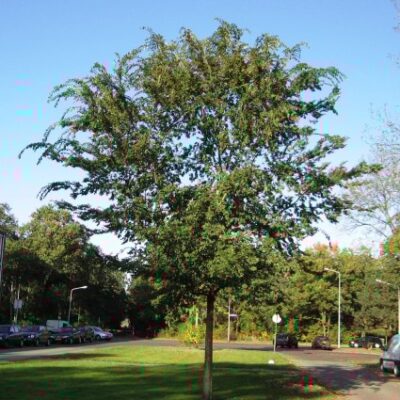Garden Plant: Lacebark Elm
Product Description: Lacebark Elm

Pretty and Tough Shade Tree Lacebark Elm
- Patterned Bark
- Nicely Rounded Canopy
- Fast-Growing
- Tolerates Poor Soil
- Pest and Disease Resistant
- Loved by Birds and Butterflies
If you need a tough shade tree that performs beautifully all year long, Lacebark Elm (Ulmus parvifolia) is up to the task. With its lovely, intricately patterned bark and attractive canopy – Lacebark Elm makes a wonderful lawn tree. The popularity of this tree has continued to grow since the 1970\’s.
It’s also rugged and highly resistant to that awful Dutch Elm disease. It can tolerate a wide variety of soils. It’s tolerant of periodic drought, if planted in well-drained soil.
This durable, attractive tree is well-known across the country by the name “Chinese Elm”. Actually, several different kinds of trees are called “Chinese Elm. “
This tree – Lacebark Elm – is an attractive tree with lovely bark. It is NOT the invasive Siberian Elm. Unfortunately, both of these trees are commonly known as Chinese Elm. The kind you want is Ulmus parvifolia, and that is the kind We sell.
Did you know? All of our customers are protected against invasive species and diseases because we use an online system called Plant Sentry. We follow every single federal, state and local regulation.
People love the fast growth rate and spreading habit of the Lacebark Elm, along with its ability to tolerate harsh conditions. So don’t worry. Even if you don’t have the greenest of thumbs, You’ll love the delicious shade cast by the dark green leaves. This shade tree is prized in areas where challenges exist for other popular tree varieties, such as in Phoenix, Arizona.
The Lacebark handles heat like a champ. It’s best known for the patterned brown gray bark that gives a lot of visual interest all year long. Known as “exfoliating”, the mottled bark grows in a very distinctive way, exposing different layers. You may see green and orange in the layers. It’s a fascinating display!
The long, arching branches and rounded form of the Lacebark Elm create a sophisticated silhouette in your outdoor living space. In summer, the Elm’s foliage fills the tree out nicely, with its glossy, serrated leaves casting a deep green shade. When fall arrives, the green leaves transform to fall color of purple and yellow to add a brilliant look to your autumn landscape.
If You’re looking for a shade tree that can withstand harsh conditions, is fast-growing and has ornamental features, then look no further. Lacebark Elm is the perfect choice for you.
How to Use Lacebark Elm in the Landscape
This deciduous shade tree is a timeless classic that adds to your property value from the minute you plant it in the ground.
Growers love the Lacebark Elm, not just because it grows to a stately height and has a regal countenance to it. They praise it for its ease of growth and minimal need for maintenance, since it thrives in even the harshest of growing conditions.
It’s fast becoming a common sight in urban plantings, where its tolerance for pollution has been widely documented. It’s not unusual to see a Lacebark Elm being used in parking lots or as municipal street trees. You’ll know how tough this tree is with these conditions!
Local birds and butterflies also appreciate this tree for both nesting and as a food source. Add a bird feeder or two to bring even more birds to your yard. You’ll love watching for them and listening to their calls.
We recommend placing the tree where You’ll get a chance to enjoy the interesting bark. The exfoliating bark of this Elm variety reveals a mottled motif with colors of red, tan, green and grey, giving it an enchanting presentation. Why not string up a hammock underneath the wide-spreading branches? Add a small table to hold your lemonade (or gin and tonic, if you prefer… ) and relax!
If you want to use it as a street tree, plant them 20 feet apart. Measure from the trunk of one, to the trunk of the next.
Pro Plant Tips for Care
The Lacebark Elm is highly resistant to Dutch Elm disease and Elm Leaf Beetle, giving it an edge over other varieties. Of course, it’s also valued for its general hardiness and ability to grow in a variety of conditions.
It does prefer well-drained soil and will display drought tolerance in that condition.
Give ample space for this tree. It will grow quickly and will develop a large root system, as required to support this large tree. Give it plenty of room to grow into the mature size listed in the Plant Highlights.
This beautiful tree is capable of growing 30 feet in the first 5 years. The ultimate full size of the Lace Bark Elm is greatly influenced by the amount of irrigation it receives.
In lawns, expect the tree to go full size within 10 to 15 years. In locations where water is regulated, the trees ultimate sizes can be 25 to 30% smaller.
Because of this fast growth rate, pruning and staking are recommended in the first few years to assure a straight trunk and a balanced canopy. Add an Arbor Springs tree kit to your order.
The Lacebark takes to pruning well. Prune in late fall to open up the canopy and shape the canopy, as desired.
Considered in many climates zones to be semi-evergreen, the Lace Bark Elm will only briefly drop leaves in the colder months. In Zones 9 and 10, the tree keeps some leaves on year-round.
The Lacebark Elm tree is always in high demand, place your order today!


